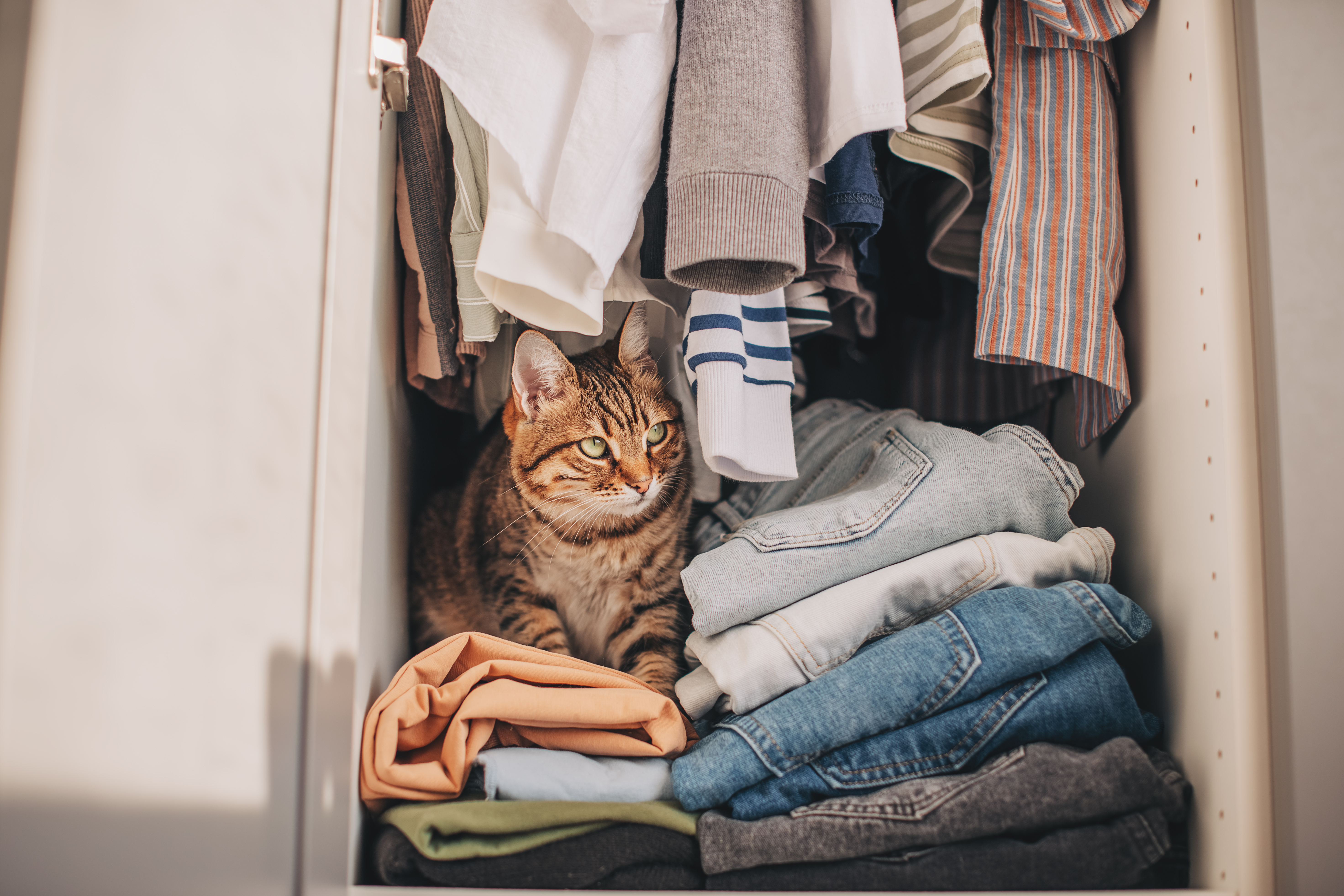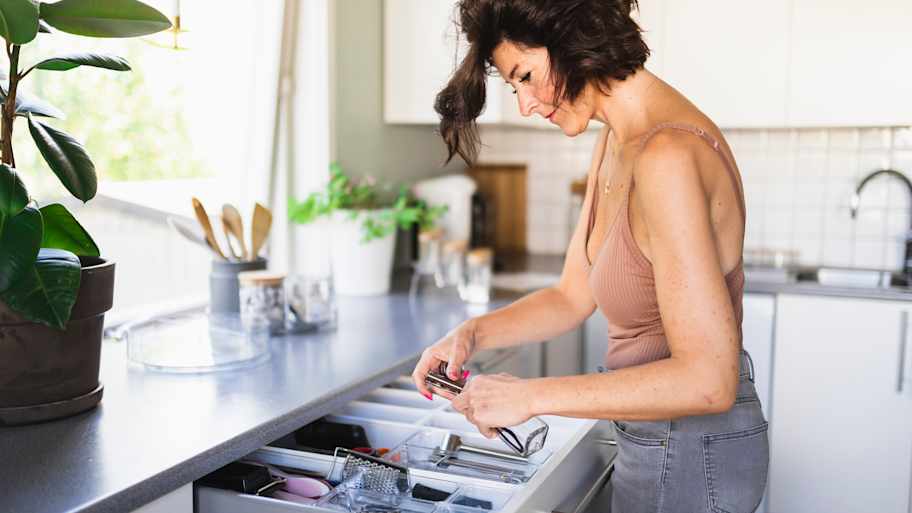
Discover the average professional organizer cost, what influences pricing, and how to budget for your next home organization project.
Declutter your home and your mind with these tips and strategies


Walking into a clean and tidy home can immediately help you feel relaxed. Plus, you won’t find yourself tripping over objects or spending hours searching for essentials. To create an orderly household, first start by decluttering your home. Empty all of your junk drawers, clear out your closet, and get rid of what you no longer need. The guide below offers 11 tips on how to declutter your home to make it more welcoming and enjoyable.

There is a curious phenomenon about our wardrobe that many people don't realize. On average, we wear about 20% of our closet and let the other 80% sit on the hangers. And since one of the top causes of clutter is hanging onto items we no longer use, the 80/20 rule can sneak up on us.
Start decluttering your home by getting real about what you wear on a regular basis and what will do better elsewhere. Here's how to go about it:
Pull any items from your drawers and closet that you haven't worn in the past month (unless it's stored for the season, of course).
Separate your pile into keepers, donations, trash, and recyclable items.
Even if you keep an item from the 80% pile, check in with it in another month to see if you decided to wear it after all.
Donation options include your local charities, donation clothing bins, or your local Buy Nothing group.
For well-worn pieces, check your city's textile recycling options. Organizations in major cities such as Wearable Collections will also host regular drives.
Decluttering doesn't have to mean tossing everything you don't use on a regular basis. Getting smarter with your storage ideas means that items will be easier to find and put back. Create systems that encourage order and won't just become another place to pile things.
For example, keep daily-use items in a reachable bin or drawer in your bathroom, but don't eat up this space with items you only use once in a blue moon. With less stuff to sort though, figuring out how to clean your bathroom on a regular basis will be far easier.
The largest enemy to all of our decluttering tips is the lack of a system. Use these decluttering sorting labels to designate specific places for all of your sorted items to go. Have a one-week rule on each of the piles to ensure that all the donations, recycling, trash, and sorted items make it to their home in less than seven days. Having a system protects you against sorting old piles into new piles and having to start the process over again.
Bring the whole family into the decluttering fold by designating a day to consider what heads in your (now labeled!) decluttering piles. Encourage kids to donate toys they no longer need and walk through the process of donation with them so they can get excited about passing things along. Additionally, encourage daily behaviors that will cut down cleaning-their-room time and keep the clutter from spreading.

It's easy to get daunted by decluttering when the whole house is staring at you. Remember, there's no reason to declutter all in one day, nor is that practical. Move one room—or even one area of a room—at a time. Start with the room that will make the most visible impact so you get attached to the feeling and jump to the next. Organizing your pantry and refrigerator, for example, will immediately affect your day-to-day.
A large and often overlooked part of the decluttering process is making a plan for larger clutter. Life is busy, and finding time to drive to the recycling center or even figuring out what you can recycle when reorganizing your home can stall the process.
Research your local recycling laws before you start, as well as which organizations currently accept and even pick up donatable items. When creating your decluttering piles, add a note about where each pile is headed.
The best part about all this donation research is that it will serve you in the long run as well. Get into a habit of donating on the same day of the month. For example, make a run to your local secondhand store, library or donation clothing bin on the second Saturday of every month. When donating becomes a part of your monthly cleaning habit, you won't have to start from scratch the next time you tackle the piles.
At the heart of every cluttered room is a pile of papers that you will totally go through this week. Keep the envelopes and bill statements from stacking up in the first place by going paperless on all of your accounts. Since it can be tricky to remember to reset all of your accounts, head to the computer each time another paper bill arrives. Not only will you watch your clutter piles shrink, but you're also cutting down your carbon footprint in the process.
As you declutter each room, make yourself a decluttering checklist for the future. There's no question that the piles will begin to sneak up again, even if they're far less than before. Create a list to stay ahead of the items that pile up over time in each room so you don't have to start from scratch next time. Your checklist may include:
Sorting through your drawers and closet once a season
Checking junk drawers and bins for unnecessary items
Putting all loose laundry, cardigans, and jackets back on hangers
Cleaning out the pantry and refrigerator at least once a month
Making a monthly trip to your donation and recycling center
Marking items for long-term storage
Removing items from high-use surfaces such as the kitchen counter and dining room table

Resetting the room before you leave is a great trick to avoid leaving a wake of clutter destruction wherever you go. If you spent some time in one room, try not to walk away without resetting it the way you'd like to find it upon your return. This can be something as simple as organizing or tossing mail before it ends up on the general pile, putting coffee mugs in the dishwasher, or placing the remote back in its designated space.

As much as we'd like to pretend that clutter magically sneaks up on us, it does come from daily habits and busy lives. Changing small behaviors can save time in the long run, however. If you're feeling lost about how to start, consider hiring a local home organizer. Professional organizers charge between $55 and $100 per hour on average, and many will offer consultation services to help you in the long run.
Decluttering doesn't need to dredge up a sense of shame or make you feel like you aren't doing enough to clean. In the long run, decluttering will free up more literal and mental space to enjoy your home. And on a few more practical notes, decluttering can:
Help you find things more easily when you're in a rush
Inspire you to use parts of your home in new ways
Simplify your wardrobe and morning routine
Diminish how much dust builds up in your home
Discourage pests from hiding or building nests
Simplify the hosting process when you throw a party
Cut down on the cost to clean your house or the cost to hire a house cleaner
Decluttering for good may take time, and everyone has busier weeks where the piles just need to stay put. Eventually, the decluttering process will become second nature, as well as catching habits that pile up over time.
Caroline Gilbert contributed to this piece.
From average costs to expert advice, get all the answers you need to get your job done.

Discover the average professional organizer cost, what influences pricing, and how to budget for your next home organization project.

These kitchen drawer organization tips will reduce time spent rifling through the kitchen looking for what you need. Learn how to organize your kitchen.

Discover small closet organization tips to maximize space, reduce clutter, and create a stylish, functional storage area that suits your needs.

When was the last time you cleaned out your spice rack or linen closet? Our list of 12 things to get rid of in just one hour helps you toss what is old, expired, or no longer needed. Decluttering is faster and easier than you might think.

Declutter and maximize your space with these eight smart storage tips for messy closets, cupboards, and drawers around your home.

Maximize space and reduce clutter with these smart laundry room organization tips that boost function and even your home’s resale appeal.